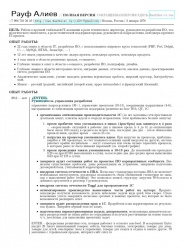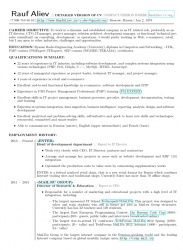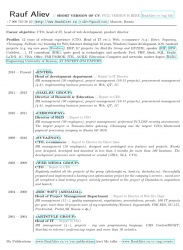Create a resume on LaTeX - how and why?
I prepare many documents in LaTeX, not in Word. And by the time when I decide on the next place of work, I summarize what was done, and, so as not to be lost, I record them in the documents that make up the framework of my CV . In my personal conviction, carefulness in creating documents for a future employer is needed not so much for communication with Eychara, as for understanding the way you are going and the direction in which you decide to move on. So why did I choose LaTeX for my resume?
A small introduction to the topic for those who do not know what LaTeX is. This is a processor, which accepts a markup language as input, giving PDF with an output document at the output. The markup language tells the processor what is in the document what, where are the pictures and why, tables, pictures, links to them, table of contents, index, footnotes, etc. are automatically printed. The ideal tool for collaboration, for complex large documents, with graphs and formulas, which can make serious changes in the middle half an hour before printing, and you need time. Can also be rendered separately style, like CSS in HTML. The author focuses on the content, and when publishing, the document styles are applied where the author’s article is included. For these reasons, all the math and physics journals are only put into LaTeX.
Let's look at the source. In the case of my resume, it looks like this: http://pastebin.com/eqM1f2AY . At first glance, it is frighteningly complicated, especially for those who hear about LaTeX for the first time. In fact, if you scroll to the middle, you can see the analogy with the markup language, and notice the logical split. For example, here is a small piece of my document from another publication document - http://pastebin.com/cy3r1paX .
')
Here is a document in PDF I get in the end:
 http://raufaliev.ru/cv/eng/full/
http://raufaliev.ru/cv/eng/full/
It is convenient for me that I can include the source of the document under the version control system and make "branches" for various needs - that is, to establish joint work on the document in the same way as it is done on the program code. It is convenient for me that in order to replace the scheme in several documents, it is enough for me to simply export the new version to the same file name on disk and with the next PDF assembly a new version will be pulled. If it turns out to be 1 cm longer, then LaTeX most likely correctly turns everything up to the end of the document, replaces all links, does not allow dangling lines, etc.
Having corrected one line in the text, I “compile” an extended version of the summary or a shortened one. If I need to put some fragment in two documents at once, I put it in a separate file and include a link to it from two documents I need. This is very useful in the case of a resume, when you have to prepare many versions for different positions.
Recruitment agencies need a Word option, since they fill in their own copy-paste forms from the resume for clients, and it's not easy to do from PDF. For LaTeX, in general, the TeX4ht converter helps, it also can export to Word. In my case, this did not help much: but on any complex documents, the layout “floats”, he does not know how to work with conditional constructions, there are other limitations. Therefore, the Word version had to be done separately - a word version . But in most cases there is a fairly tolerable result.
A very convenient means of automation of similarly designed blocks in LaTeX are macros defined by the \ newcommand command. You can parameterize any document fragment — that is, substitute # 1, # 2, # 3, and then call this piece by name instead of real blocks, passing these parameters in curly brackets after the name.
LaTeX is a great technology when:
The essential advantages of LaTeX are that almost all the “problems” with LaTeX have already been decided by everyone, everything is going well with Google. The problems are understood to be all non-standard: LaTeX does not like very much the deviations from best practice, but if it is very necessary, it allows. But you have to google and look for solutions yourself.
The disadvantage of LaTeX is the relatively poor readability of the “source code”. Control structures litter a little the text and the same tables without a look at compiled PDF are not always easy to understand. Incompatibility with HTML and Wiki, for example, does not allow the same blocks to be displayed on the web, on the Wiki, and on PDF — and this is quite a common task, for example, to keep documentation up-to-date in the print version, on the Wiki version, and in public online version for partners. Converters partly solve the problem, but you have to make a number of compromises.
As an unusual experiment, I can remember an attempt to type out presentations in LaTeX (there is a special Beamer package for this) and business ID badges with QR codes (there are also special packages). In the case of presentations, you can “one-click” to generate a slide set for a specific category of client, which is impossible in Microsoft PowerPoint. About creation of presentations on Habré already wrote . In the case of business badges, it is easier to automate the printing of complex PDFs — you need programming skills, but working with LaTeX may be more convenient than the programmer generating PDFs on his own. For example, for business cards, I once debugged a page with business cards (including auto-creating a QR code using LaTeX module), and then I fed LaTeX a list of several thousand lines Last Name-Name-Company-Position-Phone-E-mail, and on output I received a PDF of several thousand pages with a fully prepared set of business cards, with marks for bleeding, etc.
And finally, I wanted to advise the WriteLatex.Com service. It allows you to compile a document in real time, and to begin with it provides a framework that is easy to fix to fit your needs (and at the same time deal with the syntax). Such a “sandbox” in which it is easy to try out the technology. While writing the source of the document in the next window is updated PDF. Moreover, it is possible to edit documents together for several persons, and it normally “digests” simultaneous editing of one document. Using writelatex.com allows you not to set yourself a large distribution of MikTeX (Windows) or MacTex (MacOS) in order to determine how necessary and useful it is.
UPDATE: thanks- there is still a very nice analogue of writelatex fresh service Papeeria ( http://habrahabr.ru/post/179021/ ). By the way, there is authorization through VKontakte including, very unusual (but not via facebook).
A small introduction to the topic for those who do not know what LaTeX is. This is a processor, which accepts a markup language as input, giving PDF with an output document at the output. The markup language tells the processor what is in the document what, where are the pictures and why, tables, pictures, links to them, table of contents, index, footnotes, etc. are automatically printed. The ideal tool for collaboration, for complex large documents, with graphs and formulas, which can make serious changes in the middle half an hour before printing, and you need time. Can also be rendered separately style, like CSS in HTML. The author focuses on the content, and when publishing, the document styles are applied where the author’s article is included. For these reasons, all the math and physics journals are only put into LaTeX.
Let's look at the source. In the case of my resume, it looks like this: http://pastebin.com/eqM1f2AY . At first glance, it is frighteningly complicated, especially for those who hear about LaTeX for the first time. In fact, if you scroll to the middle, you can see the analogy with the markup language, and notice the logical split. For example, here is a small piece of my document from another publication document - http://pastebin.com/cy3r1paX .
')
Here is a document in PDF I get in the end:
It is convenient for me that I can include the source of the document under the version control system and make "branches" for various needs - that is, to establish joint work on the document in the same way as it is done on the program code. It is convenient for me that in order to replace the scheme in several documents, it is enough for me to simply export the new version to the same file name on disk and with the next PDF assembly a new version will be pulled. If it turns out to be 1 cm longer, then LaTeX most likely correctly turns everything up to the end of the document, replaces all links, does not allow dangling lines, etc.
Having corrected one line in the text, I “compile” an extended version of the summary or a shortened one. If I need to put some fragment in two documents at once, I put it in a separate file and include a link to it from two documents I need. This is very useful in the case of a resume, when you have to prepare many versions for different positions.
| Russian version (full) | Russian version (compact) | English version (full) | English version (compact) |
 |  |  |  |
| http://raufaliev.ru/cv/rus/full/ | http://raufaliev.ru/cv/rus/ | http://raufaliev.ru/cv/eng/full/ | http://raufaliev.ru/cv/eng/ |
Recruitment agencies need a Word option, since they fill in their own copy-paste forms from the resume for clients, and it's not easy to do from PDF. For LaTeX, in general, the TeX4ht converter helps, it also can export to Word. In my case, this did not help much: but on any complex documents, the layout “floats”, he does not know how to work with conditional constructions, there are other limitations. Therefore, the Word version had to be done separately - a word version . But in most cases there is a fairly tolerable result.
A very convenient means of automation of similarly designed blocks in LaTeX are macros defined by the \ newcommand command. You can parameterize any document fragment — that is, substitute # 1, # 2, # 3, and then call this piece by name instead of real blocks, passing these parameters in curly brackets after the name.
\documentclass[12pt]{article} \newcommand{\theline}[2] { % , \item \textbf{#1} -- #2 } \begin{document} \begin{itemize} \theline{2012-2013}{Company1} \theline{2011}{Company2} \end{itemize} \end{document} LaTeX is a great technology when:
- several documents have common blocks and I want to edit them in one place, and not in each document,
- I want to make a conditional assembly of the document - for example, do not include some set of paragraphs / sections for a specific version of the document, or include additional ones. At the same time be sure that all links, numbering, table of contents and so on. do not "break"
- a lot of people are working on their pieces and at the last minute you need to take into account their latest versions,
- the document is very complex (with footnotes, with cross-references, pictures, tables, formulas),
- there are external data that must be collected in PDF (for example, CSV),
- I do not want or do not need or do not have the time / energy / desire to think about the design, but I don’t want to give the “semi-finished product” either. LaTeX will make sure that the document looks stylish, and the author’s business is about content.
The essential advantages of LaTeX are that almost all the “problems” with LaTeX have already been decided by everyone, everything is going well with Google. The problems are understood to be all non-standard: LaTeX does not like very much the deviations from best practice, but if it is very necessary, it allows. But you have to google and look for solutions yourself.
The disadvantage of LaTeX is the relatively poor readability of the “source code”. Control structures litter a little the text and the same tables without a look at compiled PDF are not always easy to understand. Incompatibility with HTML and Wiki, for example, does not allow the same blocks to be displayed on the web, on the Wiki, and on PDF — and this is quite a common task, for example, to keep documentation up-to-date in the print version, on the Wiki version, and in public online version for partners. Converters partly solve the problem, but you have to make a number of compromises.
As an unusual experiment, I can remember an attempt to type out presentations in LaTeX (there is a special Beamer package for this) and business ID badges with QR codes (there are also special packages). In the case of presentations, you can “one-click” to generate a slide set for a specific category of client, which is impossible in Microsoft PowerPoint. About creation of presentations on Habré already wrote . In the case of business badges, it is easier to automate the printing of complex PDFs — you need programming skills, but working with LaTeX may be more convenient than the programmer generating PDFs on his own. For example, for business cards, I once debugged a page with business cards (including auto-creating a QR code using LaTeX module), and then I fed LaTeX a list of several thousand lines Last Name-Name-Company-Position-Phone-E-mail, and on output I received a PDF of several thousand pages with a fully prepared set of business cards, with marks for bleeding, etc.
And finally, I wanted to advise the WriteLatex.Com service. It allows you to compile a document in real time, and to begin with it provides a framework that is easy to fix to fit your needs (and at the same time deal with the syntax). Such a “sandbox” in which it is easy to try out the technology. While writing the source of the document in the next window is updated PDF. Moreover, it is possible to edit documents together for several persons, and it normally “digests” simultaneous editing of one document. Using writelatex.com allows you not to set yourself a large distribution of MikTeX (Windows) or MacTex (MacOS) in order to determine how necessary and useful it is.
UPDATE: thanks
Source: https://habr.com/ru/post/187496/
All Articles